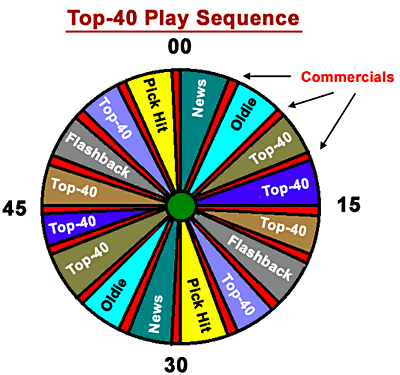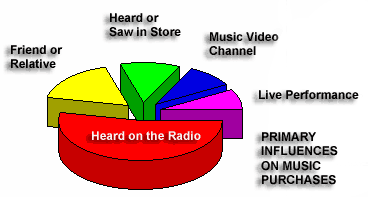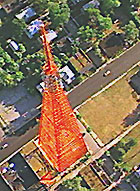Film, Radio and TV - 22a |
Radio Part I
When television started taking hold with audiences in the 1940s and 50s, radio lost a major share of its audience. In particular, the audiences for The radio networks, which had been the source of most of this programming, also fell into decline. Radio fought against the insurgence of TV for several years. Some radio stations were so threatened by TV that they refused to allow commercials for TV sets to air on their stations. But, as in most cases with significant advances in technology, it was a losing battle. A few AM radio stations, especially in the smaller markets (broadcast areas), started losing money and eventually shut down. Most survived, but found that advertising dollars had suddenly been diverted toward the expensive TV medium. Radio had to change, and it did change, primarily by specializing its programming. First, many stations started dividing listener days into dayparts, or programming segments that correspond to typical listener activities.
Here is how a typical dayparting approach works. In the morning and afternoons during drive time news, weather, and traffic reports are emphasized, generally with chatty DJs. During afternoons, there may be background music for work or household activities. In the case of news/talk stations (to be discussed below), there may be an emphasis on feature stories or listener call-in and discussion shows. In the early evenings there will probably be a younger audience. They may be studying, surfing the Internet, or talking on the telephone while others watch television. For this audience some stations feature background music, or pop music and request lines. Late night radio may get into more avant-garde fare--music with lyrics not suitable for general audiences, or call-in shows that regularly wander into racy topics.
Even with dayparting and music designed to appeal to different age groups and geographic areas, radio was still struggling. What was needed was something new to attract and hold radio listeners. That "something" was rock music, a format that would in its various forms dominate music play lists for Rock music quickly became the focus for much of the late afternoon and early evening radio programming--time periods that were attractive to the youth market. But rock music wasn't only attractive to teenagers. During the late morning and early afternoon hours, housewives who weren't listening to soap operas on TV also tuned in. Radio didn't demand as much attention as TV, and they could listen to the radio while they did housework. Rock music was also a boon for the record business. Competition among record companies and recording artists led to compiling lists of top-selling records. This in turn led to a weekly listing of the top 100 best-selling records. Since 100 was a bit of an unwieldy list for radio station play lists, the number was typically cut down to the 40 most popular records--the top-40.
To match the vitality and fury of the music, a new generation of disc jockeys (DJs) was born that included Alan Freed, Murry the K, and Wolfman Jack. As competition between stations increased, on-air DJ approaches reached frantic levels. Even a second of on-air silence seemed like a cardinal sin. Good music was loud music, and AM stations used various technical means to maximize the loudness of their signals, including electronically compressing audio signals to make sure everything was transmitted at a "maximum loud" level. This, of course, destroyed the music balance intended by the recording artists and engineers. To make things move faster (and get through more records in less time) some stations altered turntable (record player) speeds to slightly speed up records. Things got to a point that in some DJs regularly rang bells, blew whistles, played strange sound effects, and even smashed things in the studio to add to the cumulative fury. As competition between stations increased and audience survey methods became more exact, station program directors looked for other ways to get an advantage over their competition. This included giveaways, and zany on-air antics. Success stories at some stations prompted imitation in other markets. Soon, programming formulas emerged that were designed to attract and hold audiences. Many stations used a play sequence based on the clock. It was posted on the wall right in front of announcers, and they were required to follow it on an hour-by-hour basis. Here is one example. |
Note that eight of the top-40 songs are played each hour. This means that in each five-hour period all of the top-40 songs will be aired. At that point the whole sequence starts again. Each Saturday when the week's most popular songs are tabulated, these stations often did a "top-40 countdown," starting with number 40 song and gradually working up (with great fanfare) to the number one song of the week. Many country music stations followed--and still follow--the same approach. Top-40 and country music formats are among the most popular and easy to identify. But these are only two formats, and most metropolitan areas have more than a dozen radio stations. (The greater Los Angles area has 87 radio stations, which is probably a record for any metropolitan area.) Although it was originally thought that radio would kill the recorded music business--another case of premature paranoia--as you can see from the graph on the right, just the opposite happened. Most people cite hearing music on radio as being the primary reason they buy a particular CD.
To meet other audience interests there were other types of music: classical, jazz, religious, easy listening, old standards, etc. When disco arrived, some stations adopted a disco music format. One station even tried to specialize in polka music. Because of FM radio's superior audio quality and stereophonic sound, audiences slowly shifted to FM stations for music. At this point, many AM radio stations had to again adjust their area of specialization. Since talk works about as well on AM as it does on FM, many AM stations started moving away from music--especially in large metropolitan areas. "All-talk," and "all-news" AM stations appeared, although the latter generally ended up being news summaries read from a wire service surrounded by traffic and weather reports. To this was typically added commentary on events provided by station personnel and listeners who would call in. The move toward specialized formats didn't bring radio back to its golden age era by any means, but it tended to stabilize the decline in audiences. (Click on "more" for the second half of this section.) |
To next module To
index © 1996 - 2005, All Rights Reserved.
|
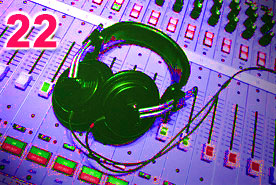
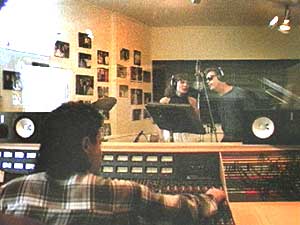 decades to come.
decades to come.